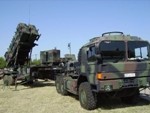 Israel’s cutting-edge missile defense called Iron Dome scored an 85 percent success rate in knocking out rockets launched against Israel’s southern cities in recent clashes with Gaza.
Israel’s cutting-edge missile defense called Iron Dome scored an 85 percent success rate in knocking out rockets launched against Israel’s southern cities in recent clashes with Gaza.
“Iron Dome in April became the first anti-ballistic missile system to be used in combat,” said Michael Oren, Israel’s ambassador to the United States.
Israeli officials said the country’s two batteries of Iron Dome missile interceptors shot down Russian-made Grad and Qassam rockets fired from Gaza positions by smaller terrorist groups such as the Popular Resistance Committees and Palestinian Islamic Jihad.
The battlefield success of Iron Dome could change the political calculus in Israel by providing protection against attacks that prevented Israel from withdrawing after it dismantled settlements in Gaza in 2005.
Mr. Oren said 1,000 Qassam rockets were fired into southern Israel from August 2005 to May 2006. At the time, Prime Minister Ariel Sharon formed a political party, Kadima, to complete what he called disengagement, or the withdrawal of Israeli forces and the dismantlement of settlements in Palestinian areas of the West Bank that the Jewish state did not intend to keep within its final borders. The continuous barrage of rockets from Gaza is widely seen as stopping disengagement in its tracks.
A rocket is launched from a new Israeli anti-missile system known as Iron Dome in order to intercept a rocket fired by Palestinian militants from the Gaza Strip, in the southern city of Beersheba, Israel, on Aug. 21, 2011. (Associated Press)
“This restores Israel’s deterrence against a weapons system that Israel’s enemies believed Israel was incapable of defending against,” said Patrick Clawson, the director of research for the Washington Institute for Near East Policy. “Second, by doing that, it makes it politically possible to talk about trading territory for peace, even if you are not confident that the new authorities can stop missile attacks by terrorists from that territory.”
The Obama administration has supported Iron Dome. In the current defense budget, the Pentagon provides $205 million for Iron Dome deployments, in addition to the nearly $3 billion Israel received in U.S. military financing for 2011.
Rep. Steven R. Rothman, a New Jersey Democrat who is the lead lawmaker on the House Appropriations Committee that secured the additional money for Iron Dome, said the missile defense system “serves as an essential part of Israel’s multilayered umbrella of anti-rocket and anti-missile defenses, and over the past week this system has shown just how capable it is.”
A former senior Israeli defense official with detailed knowledge of the Iron Dome system said it is a crucial element of Israeli defenses. “But it is not a silver bullet because there will always be 10 times more rockets than Iron Dome interceptors can stop,” he said.
Despite the high success rate, one Grad rocket did get past the Iron Dome battery protecting the Israeli city of Be’er Sheva, killing one and wounding eight, according to Israeli news reports.
Mr. Oren said the Iron Dome system can distinguish between rockets and missiles that will land in civilian areas and rockets that do not need to be intercepted because they will impact in remote areas.
One criticism of Iron Dome is that it costs about $100,000 to fire an interceptor, compared with the cost of about $1,000 for Palestinians to fire a Qassam rocket.
Einat Wilf, a member of Israel’s Knesset who serves on the foreign affairs and defense committees, said “the cost is a major issue with Iron Dome.”
She added that the system works well for populated areas and strategic targets. “We don’t use it to stop everything. This is one way to balance the equation financially,” Ms. Wilf said.
Ms. Wilf also said Iron Dome cannot defend areas close to rocket launch areas, such as the southern Israeli town of Sderot.Carl Sherer, an Israeli blogger who closely follows the development of Iron Dome, said the system cannot operate at short distance.
“They don’t deploy at anything less than 7 kilometers from Gaza,” he said. “This means that Israel’s cities that are less than 7 kilometers from Gaza, like Sderot, can’t be covered by Iron Dome because it takes too long for the human being operating the system to fire on the rocket after its launched from Gaza.”
Mr. Clawson said Iron Dome still could end up doing for missile attacks what Israel’s security barrier did to stop the threat of suicide bombers.
“The concern was how do you stop suicide bombers, and the answer was the security barrier,” Mr. Clawson said. “Now the problem has been missiles, short range missiles and rockets. Iron Dome is making a big dent on this problem.”
{The Washington Times/Matzav.com Newscenter}











According to the latest issue of Aviation Week and Space Technology, page 34, an Israeli Defense official is quoted as saying the success rate is 78%.
The IDF is seriously concerned about Iron Domes performance, and that is only against the short range Grads and Kassams. The Fajr-5s (70 km range, capable of reaching Tel Aviv) fall between the capabilities of Iron Dome and Arrow, and could be even more problematic.